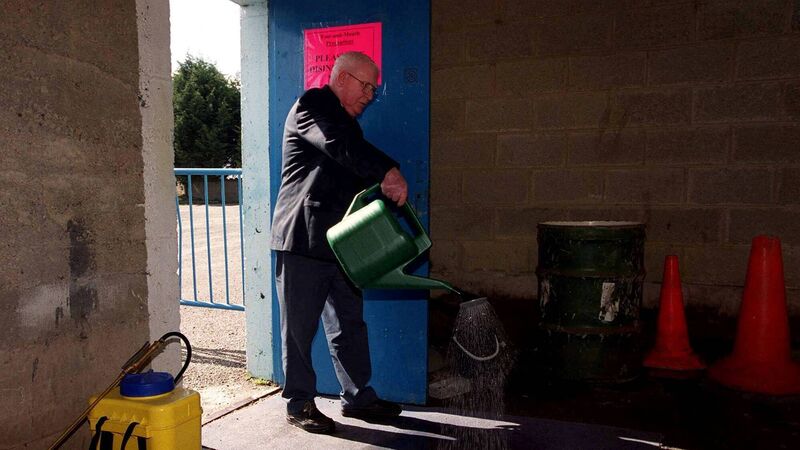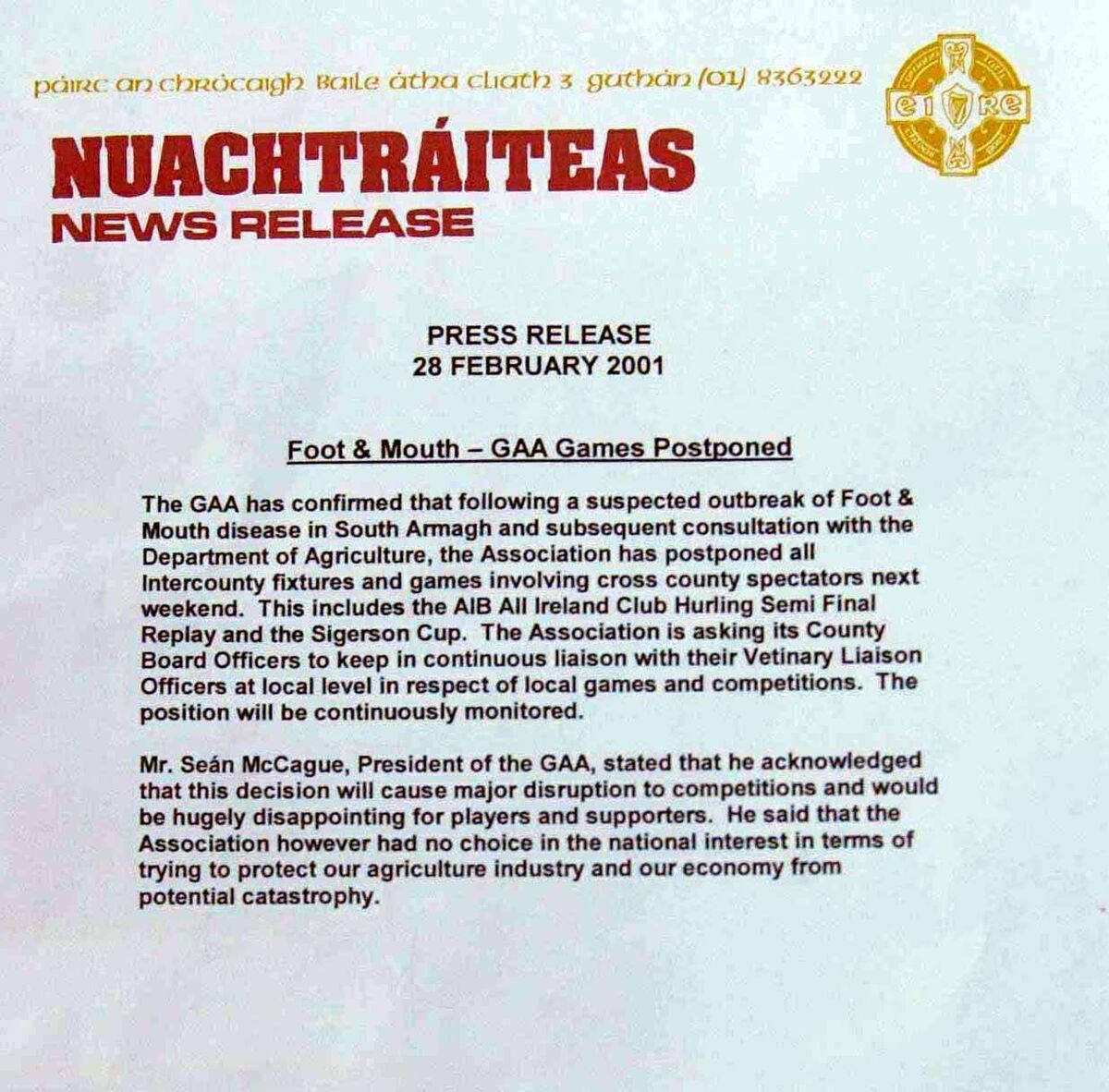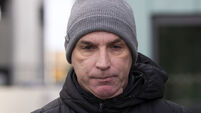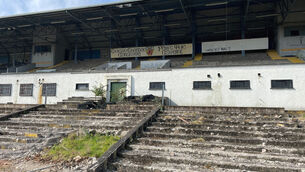Paul Rouse: A second spring of GAA uncertainty in 20 years

Pat King, a member of the ground staff at Semple Stadium, sprays disinfectant on to a matt at an entrance in an effort to stop the spread of Foot and Mouth Disease before the 2001
All-Ireland Club SHC semi-final replay between Graigue Ballycallan and Sixmilebridge at Semple Stadium.
The iconic historic image of 2001 will always be the sight of two airliners flying into the twin towers of the World Trade Center in New York. It was an event that marked a turning in global history. But on a more local level, the most striking images were also of plumes of smoke rising toward the sky. In Britain —where more than six million cows and sheep were killed — distraught farmers burned pyres of animals in an attempt to contain an outbreak of Foot and Mouth disease.
Ireland had been free of Foot and Mouth since 1941. The disease manifests itself as lameness and mouth blisters in cattle, sheep, and goats. Humans are seldom infected, and if they are it is ordinarily temporary and mild impact.
When the outbreak spread to Ireland, with news that a case had been detected in Co Armagh, there was grave concern for Irish farming. Nobody who understood the travel arrangements of Irish sheep and cattle in the border area doubted that it would be long before the disease was manifest south of the border.
As one farmer said: “The actions of a handful of individuals involved in cross-border smuggling can only be described as treason.”
Eventually, the disease did indeed manifest itself in the Republic of Ireland. The impact on one Co Louth farmer, Owen Wherly, was brutal: he lost more than 400 sheep in a cull and it was a devastating experience. He told Mairéad Lavery in a piece for the entitled: ‘Slaughter at Cooley’: “Things will never be the same again. The black-faced mountainy ewes of Cooley knew their own piece of the mountain, and you can never compensate for that. Like yesterday, it’s over and gone, and now we have to cope with today.
As well as the cull of sheep, Irish army snipers shot wild animals, such as deer, which were considered capable of bearing the disease from the area. Other troops had already been deployed to Dublin Port, as part of extensive precautionary measures to stop the spread of the disease. Disinfection mats were placed at the entry to all buildings in the state where there was significant footfall.
Coillte forests and a whole range of playgrounds and other public amenities were closed to the public, while people were asked to stay away from canal towpaths and walkways in rural areas.
It was in this context that sporting events — in concert with many other public events and gatherings— were cancelled. Most strikingly, the 2001 St Patrick’s Day festival was postponed from March 17 (although it was rescheduled two months later in May, leading to calls for this change to be made permanently).
On the Tuesday (February 27) before Ireland were due to play Wales in the Six Nations in Cardiff, Ireland’s then Minister for Agriculture Joe Walsh had the match cancelled.
It was by then impossible for the governing bodies of sport not to act. All horse racing in the country was banned, followed quickly by greyhound racing. Rugby and soccer clubs were directed by their governing bodies to cancel all fixtures; they were joined by motor racing, and the governing bodies of sports such as athletics, rowing, boxing, basketball, and hockey.
All GAA other fixtures were also cancelled. These included the planned All-Ireland Club hurling semi-final replay between Sixmilebridge and Graigue Ballycallan due to be played in Thurles.
Schools and colleges matches, as well as club matches, were cancelled. As Shane Murray reported on RTÉ, almost 10,000 GAA fixtures alone were not played on that first weekend alone, leaving up to 300,000 players without games.

When news came of a fresh outbreak in Tyrone, the Ulster U21 football final was postponed. With the All-Ireland U21 final due to be played in April there was talk that the competition would be played without Tyrone.
But first the Munster finalists — Limerick and Cork — wrote to Croke Park to say they wished to allow Tyrone be given time. As Sean Moran reported, Mayo, who were by then already in the All-Ireland final, said that they too did not wish to win the All-Ireland without the Ulster champions being accommodated.
As it turned out, Tyrone — trained by Mickey Harte — went on to the All-Ireland final and ultimately won it. It was a landmark moment on the path to ultimate senior success.
Through all of this, sporting events in England continued almost unchecked. There was very little disruption, apart from the fact the horse racing was ceased for eight days.
But the full league programme of soccer matches in England continued and there continued to be Irish soccer supporters who travelled over for matches. Although Ireland’s rugby match with Scotland was postponed , as well as the one against Wales — a full house attended Twickenham to watch England play Scotland.
The contrasting responses from the UK and Irish governments to the Foot and Mouth outbreak in terms of the cessation of sporting activity was rooted in the relative importance of agriculture to the economies of both islands.
It is true that the number of people whose principal income was farming had been declining by almost 2% per annum since the 1960s in the Republic of Ireland. But the importance of beef exports to Ireland’s family farms and beef exports to Ireland’s Gross Domestic Product was enormous. Similarly, north of the border, more than 80% of farmers were beef production operations that revolved around small herds. Culturally, also, farming held a centrality in social and political life that was simply not evident in Britain.
And among Irish farmers, there was gratitude for the sacrifices made. The letters page of the carried thanks from farmers and others in the meat industry to “all the Irish sporting bodies for their immediate and rapid response in banning all sporting activities — the Racing Board, the IRFU, the GAA, and coursing clubs, athletic associations, and all others at great inconvenience and cost to them and their members.”
In truth, Irish sporting organisations recovered quickly from the upheavals of the Foot and Mouth outbreak.
Barely a month of play was lost.
There is no meaningful comparison to be made with the losses of Covid-19. If there is a legacy, it is to be found in rugby. Ireland had started the Six Nations campaign with win over France and Italy. When the competition resumed in the autumn, they were stunned by Scotland on their first day back.
It is not possible to say Ireland would have completed a Grand Slam, but they beat Wales and England in their final fixtures. And — with England on their way to winning the Rugby World Cup in 2003 — that was one of the sweetest victories in Irish rugby history.








